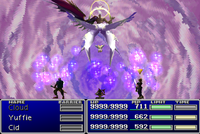Supernova
| Supernova | |
|---|---|
| User | Sephiroth |
| Universe | Final Fantasy |
Supernova is Sephiroth's Final Smash.
Overview
Sephiroth swings his sword forward, catching up to three opponents. A cutscene initiates in which he transforms into Safer Sephiroth, followed by summoning a meteor that passes through a planet and into a star, causing the star to explode and destroy an Earth-like planet. The trapped opponents are then launched.
The move has a random effect on each opponent it launches. In addition to dealing a total of 32% damage, each will suffer from one randomly chosen "debuff":
- Being put to sleep.
- Gaining a very large flower.
- Have their controls reversed.
- Enter their shield break state. They are not simply stunned; they go through the full shield break process. As a result, Jigglypuff is blasted upwards as is typical for its shield break.
- Getting slowed down.
- Being launched a little further than usual, with a darkness effect.
Instructional Quotes
| Swing the sword forward in a wide range. If it hits an opponent, Safer Sephiroth will appear and deal massive damage with a supernova explosion that can also sometimes inflict status effects. The first swing can hit up to three opponents. |
Origin
Safer∙Sephiroth is the form that Sephiroth takes during the third phase of the final battle in Final Fantasy VII. Despite this being the second-to-last phase, Safer∙Sephiroth is considered the final challenge of the main story, since it's followed by a cinematic battle that cannot be lost. This is the body that Sephiroth was constructing for himself in the Northern Cave, as part of his plan to absorb the lifestream and become a god.
Supernova, formatted as "Super Nova" in Final Fantasy VII, is Safer∙Sephiroth's ultimate attack. The Final Smash is based on the move from the international version of FFVII, which has become infamous for its lengthy battle animation, which takes a full two minutes to execute[1] and causes the player to sit through the animation of their party's health dropping, which can take a significant amount of time when they have reached their level cap. It involves summoning a meteor to ravage the galaxy and turn the Sun into a supernova that engulfs the Planet, dealing fractional damage equal to 15/16 of the party's current HP and inflicting random status ailments on them. The original Japanese version of the move has a much shorter animation clocking in at 20 seconds[2] and deals non-fractional damage, making it possible to wipe out the party.
The Final Smash is able to trap up to three opponents at once, referencing the number of available party member slots in Final Fantasy VII; when the move is activated, the three trapped players will face Safer∙Sephiroth, as the party does in the boss battle.
Gallery
Sephiroth using Supernova as shown by the Move List in Ultimate.
Trivia
- Using this move against Mr. Game & Watch will show his model in 3D, as with Triple Wolf.
- This is the third cinematic Final Smash for a DLC character that can catch more than one character, after both All-Out Attack and Gigaslash.
- Supernova is the longest cinematic Final Smash in series history, at around 8 seconds, beating the previous record held by Gigaslash, which was around 7 seconds.
- Coincidentally, this mirrors Supernova's infamously long length in the international version of Final Fantasy VII, albeit not to the same extreme extent.
- Unlike in the original Final Fantasy VII, which applied mathematical equations in the field of astrophysics to determine the overall conditions needed to perform Super Nova (which infamously based the conditions around if the celestial body that would trigger the supernova was operating on a two dimensional plane, which was a flat circle, as well as ignoring that the Sun itself in astronomical terms is designated as a main sequence star, and itself is unable to go supernova due to a lack of mass), the equations depicted during the sequence instead are well-known formulas that apply to quantum mechanics and spacetime, such as the Hellmann-Feynman theorem and the Einstein gravitational constant.



